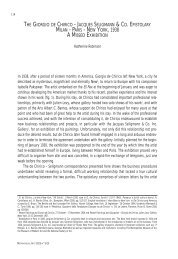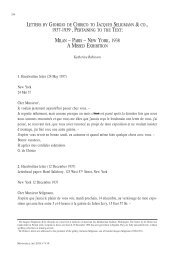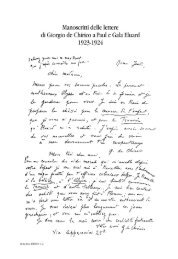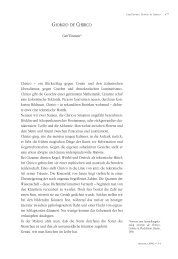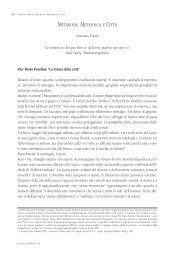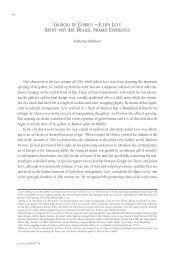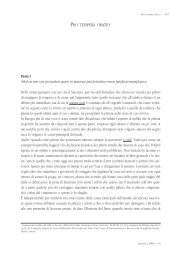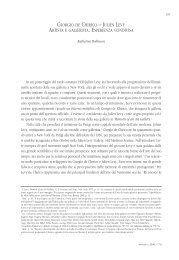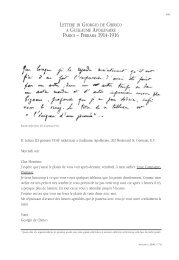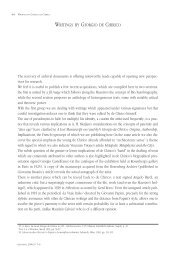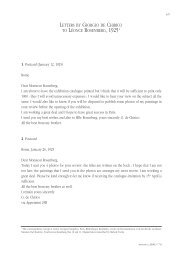Emplastic Oil - Fondazione Giorgio e Isa de Chirico
Emplastic Oil - Fondazione Giorgio e Isa de Chirico
Emplastic Oil - Fondazione Giorgio e Isa de Chirico
You also want an ePaper? Increase the reach of your titles
YUMPU automatically turns print PDFs into web optimized ePapers that Google loves.
166<br />
SALVATORE VACANTI: FROM MURAL PAINTING TO “EMPLASTIC OIL”<br />
fig. 6 Afro, Self-portrait, c. 1935, tempera<br />
and oil on canvas, Galleria Nazionale d’Arte<br />
Mo<strong>de</strong>rna, Rome<br />
to Painters). 30 The text, published in May 1933, ignited a passionate<br />
<strong>de</strong>bate on mural painting, whose other key moment<br />
occurred in December 1933 with the publishing of the<br />
Manifesto <strong>de</strong>lla pittura murale (Manifesto on Mural Painting) 31<br />
signed by Sironi, Campigli, Carrà and Funi, in “La Colonna”. 32<br />
Young Afro Basal<strong>de</strong>lla proves an interesting case in the<br />
context of the 1930s discussion on mural painting. The<br />
restorations carried out by the Superinten<strong>de</strong>nce of the<br />
Autonomous Region of Friuli Venezia Giulia on his mural<br />
paintings in his native city Udine 33 reveal a predilection for<br />
oil tempera. This choice can only be un<strong>de</strong>rstood in the context<br />
of the technical-formal <strong>de</strong>bate of those years and of<br />
Afro’s association with Corrado Cagli. In<strong>de</strong>ed, as far as is<br />
known, Afro never used “fresco”, probably due to Cagli’s<br />
influence. The latter drew Afro close to his artistic vision of<br />
primordio, guiding him away from the i<strong>de</strong>ological use of fresco<br />
that was inherent to the Italian Novecento, in particular<br />
Sironi. Contemporary critics had also noticed Afro’s preference<br />
for oil tempera as is evi<strong>de</strong>nced in Luigi Aversano’s<br />
review of Afro's 1937 solo exhibition at Rome’s Galleria La Cometa. 34 It seems therefore possible to<br />
accept the thesis of Teresa Perusini 35 , according to which in those years the artist used oil tempera<br />
in his easel paintings (fig. 6) as well as in his mural paintings. Perusini also hypothesised that Afro’s<br />
methods originated in the reading of <strong>de</strong> <strong>Chirico</strong>’s Small Treatise.<br />
During the 1930s the issue of technique became fundamental for the rebirth of mural painting,<br />
as is <strong>de</strong>monstrated by the controversy over the poor condition of the works at the V Triennale. The<br />
choice of technique was as crucial a matter as the problem of the relationship between Art and<br />
Architecture, and as the subject matter itself. Hence, an i<strong>de</strong>ological bridge seems to link the <strong>de</strong>bate<br />
over “craft” of the early twenties, first enkindled by <strong>de</strong> <strong>Chirico</strong> during the “Valori Plastici” period,<br />
with the research of the early 1930s. However, the culture of the 1920s, which was rich with technical<br />
principals and references to tradition, would go on to acquire i<strong>de</strong>ological nuances in the 1930s.<br />
30<br />
C. Cagli, Muri ai Pittori, in “Quadrante”, Milan May 1933; republished in Il Cagli romano: anni Venti-Trenta, exhibition catalogue E. Crispoliti ed.,<br />
Electa, Milan 1985, pp. 74-75.<br />
31<br />
M. Sironi, Manifesto <strong>de</strong>lla pittura murale, in “La Colonna”, Milan, December 1933; republished in M. Sironi, Scritti e Pensieri, E. Ponteggia, ed.,<br />
Abscondita, Milan 2002, pp. 43-46.<br />
32<br />
See Muri ai pittori. Pittura murale e <strong>de</strong>corazione in Italia 1930-1950, exhibition catalogue edited by V. Fagone, G. Ginex, T. Sparagni, Mazzotta,<br />
Milan 1999.<br />
33<br />
See P. Casadio, I. Reale, La riscoperta <strong>de</strong>lle tempere murali di Afro nel collegio <strong>de</strong>ll’ONB a Udine, in “Bollettino d’Arte”, no. 58, 1989, pp. 73-86.<br />
34<br />
L. Aversano, Afro Basal<strong>de</strong>lla a Roma, in “La Panarie”, no. 75, Udine, May-June 1937; cited in A. Masi, 1929-1942: Afro Basa<strong>de</strong>lla dalla formazione<br />
agli anni romani, in Afro: il colore dal paesaggio all’astrazione, exhibition catalogue edited by Archivio Afro, G. Mercurio, Skira, Milan 2003, p.140.<br />
35<br />
See T. Perusini, Le pitture murali di Afro Basal<strong>de</strong>lla tra il 1936 ed il 1955: analisi storico-tecnica e problemi di conservazione, in Architettura e materiali<br />
<strong>de</strong>l Novecento: conservazione, restauro, manutenzione, Atti <strong>de</strong>l Convegno di Studi (Bressanone, 2004), edited by G. Biscontin e G. Driussi, Edizioni<br />
Ardacia Ricerche, Venice 2004, pp. 249-260.<br />
METAPHYSICAL ART 2010|N° 9/10



